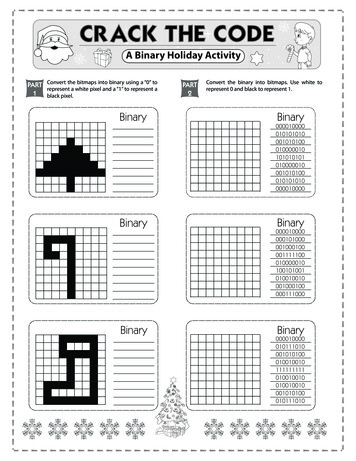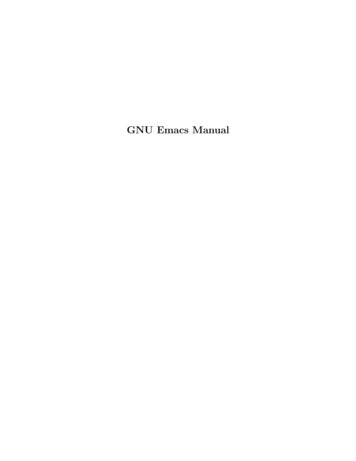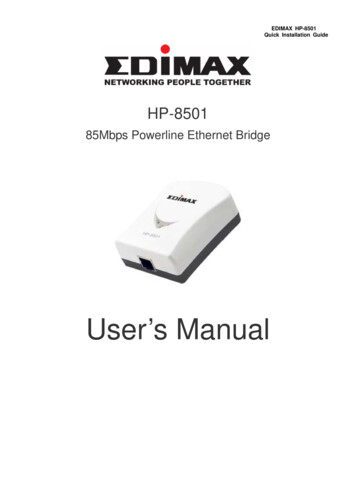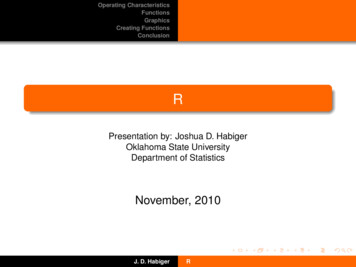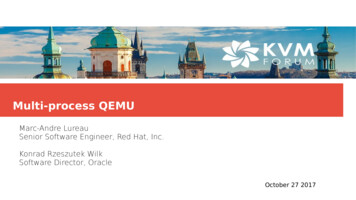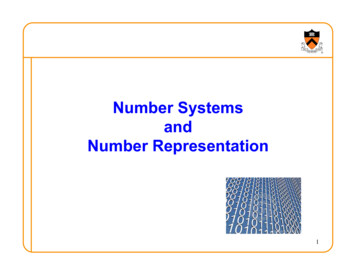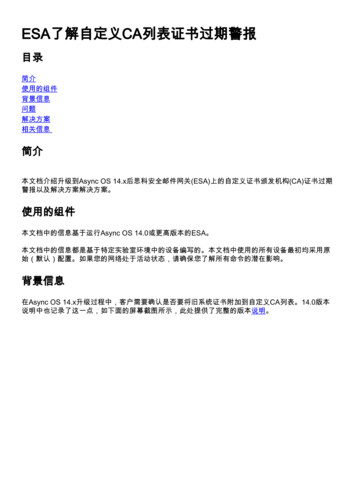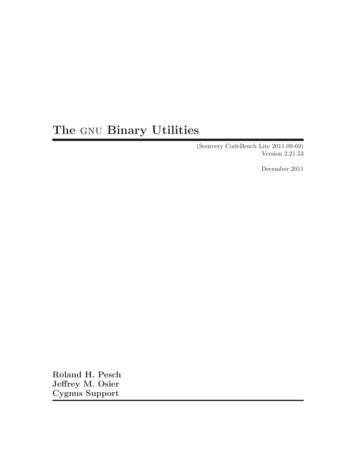
Transcription
The gnu Binary Utilities(Sourcery CodeBench Lite 2011.09-69)Version 2.21.53December 2011Roland H. PeschJeffrey M. OsierCygnus Support
Cygnus SupportTexinfo 2009-03-28.05Copyright c 1991, 1992, 1993, 1994, 1995, 1996, 1997, 1998, 1999, 2000, 2001, 2002, 2003,2004, 2005, 2006, 2007, 2008, 2009, 2010, 2011 Free Software Foundation, Inc.Permission is granted to copy, distribute and/or modify this document under the terms ofthe GNU Free Documentation License, Version 1.3 or any later version published by theFree Software Foundation; with no Invariant Sections, with no Front-Cover Texts, and withno Back-Cover Texts. A copy of the license is included in the section entitled “GNU FreeDocumentation License”.
iTable of ContentsIntroduction . . . . . . . . . . . . . . . . . . . . . . . . . . . . . . . . . . . . . . . . 11ar . . . . . . . . . . . . . . . . . . . . . . . . . . . . . . . . . . . . . . . . . . . . . . . . 21.11.2Controlling ar on the Command Line . . . . . . . . . . . . . . . . . . . . . . . . . . . 3Controlling ar with a Script . . . . . . . . . . . . . . . . . . . . . . . . . . . . . . . . . . . . 62ld . . . . . . . . . . . . . . . . . . . . . . . . . . . . . . . . . . . . . . . . . . . . . . . . . 93nm . . . . . . . . . . . . . . . . . . . . . . . . . . . . . . . . . . . . . . . . . . . . . . 104objcopy . . . . . . . . . . . . . . . . . . . . . . . . . . . . . . . . . . . . . . . . . 155objdump . . . . . . . . . . . . . . . . . . . . . . . . . . . . . . . . . . . . . . . 276ranlib . . . . . . . . . . . . . . . . . . . . . . . . . . . . . . . . . . . . . . . . . . . 367size . . . . . . . . . . . . . . . . . . . . . . . . . . . . . . . . . . . . . . . . . . . . . 378strings . . . . . . . . . . . . . . . . . . . . . . . . . . . . . . . . . . . . . . . . . . 399strip . . . . . . . . . . . . . . . . . . . . . . . . . . . . . . . . . . . . . . . . . . . . 4110c filt . . . . . . . . . . . . . . . . . . . . . . . . . . . . . . . . . . . . . . . . 4411addr2line . . . . . . . . . . . . . . . . . . . . . . . . . . . . . . . . . . . . . . 4612nlmconv . . . . . . . . . . . . . . . . . . . . . . . . . . . . . . . . . . . . . . . 4813windmc . . . . . . . . . . . . . . . . . . . . . . . . . . . . . . . . . . . . . . . 5014windres. . . . . . . . . . . . . . . . . . . . . . . . . . . . . . . . . . . . . . . . 5315dlltool . . . . . . . . . . . . . . . . . . . . . . . . . . . . . . . . . . . . . . . . . 5615.116The format of the dlltool ‘.def’ file . . . . . . . . . . . . . . . . . . . . . . . . 61readelf . . . . . . . . . . . . . . . . . . . . . . . . . . . . . . . . . . . . . . . . . 62
ii17elfedit . . . . . . . . . . . . . . . . . . . . . . . . . . . . . . . . . . . . . . . . . 6618Common Options . . . . . . . . . . . . . . . . . . . . . . . . . . . . 6819Selecting the Target System. . . . . . . . . . . . . . . . . 6919.119.220Target Selection . . . . . . . . . . . . . . . . . . . . . . . . . . . . . . . . . . . . . . . . . . . . . 69Architecture Selection . . . . . . . . . . . . . . . . . . . . . . . . . . . . . . . . . . . . . . . . 70Reporting Bugs . . . . . . . . . . . . . . . . . . . . . . . . . . . . . . 7120.120.2Have You Found a Bug? . . . . . . . . . . . . . . . . . . . . . . . . . . . . . . . . . . . . . 71How to Report Bugs . . . . . . . . . . . . . . . . . . . . . . . . . . . . . . . . . . . . . . . . . 71Appendix A GNU Free Documentation License. . . . . . . . . . . . . . . . . . . . . . . . . . . . . . . . . . . . . . . . . . . . . . . . 74Binutils Index . . . . . . . . . . . . . . . . . . . . . . . . . . . . . . . . . . . . . 82
Introduction1IntroductionThis brief manual contains documentation for the gnu binary utilities (Sourcery CodeBenchLite 2011.09-69) version 2.21.53:arCreate, modify, and extract from archivesnmList symbols from object filesobjcopyCopy and translate object filesobjdumpDisplay information from object filesranlibGenerate index to archive contentsreadelfDisplay the contents of ELF format files.sizeList file section sizes and total sizestringsList printable strings from filesstripDiscard symbolselfeditUpdate the ELF header of ELF files.c filtDemangle encoded C symbols (on MS-DOS, this program is named cxxfilt)addr2lineConvert addresses into file names and line numbersnlmconvConvert object code into a Netware Loadable ModulewindresManipulate Windows resourceswindmcGenertor for Windows message resourcesdlltoolCreate the files needed to build and use Dynamic Link LibrariesThis document is distributed under the terms of the GNU Free Documentation Licenseversion 1.3. A copy of the license is included in the section entitled “GNU Free Documentation License”.
Chapter 1: ar21 arar [‘--plugin’ name ] [-]p [mod [relpos ] [count ]] [‘--target’ bfdname ] archive [member .]ar -M [ mri-script ]The gnu ar program creates, modifies, and extracts from archives. An archive is a singlefile holding a collection of other files in a structure that makes it possible to retrieve theoriginal individual files (called members of the archive).The original files’ contents, mode (permissions), timestamp, owner, and group are preserved in the archive, and can be restored on extraction.gnu ar can maintain archives whose members have names of any length; however, depending on how ar is configured on your system, a limit on member-name length may beimposed for compatibility with archive formats maintained with other tools. If it exists, thelimit is often 15 characters (typical of formats related to a.out) or 16 characters (typical offormats related to coff).ar is considered a binary utility because archives of this sort are most often used aslibraries holding commonly needed subroutines.ar creates an index to the symbols defined in relocatable object modules in the archivewhen you specify the modifier ‘s’. Once created, this index is updated in the archivewhenever ar makes a change to its contents (save for the ‘q’ update operation). An archivewith such an index speeds up linking to the library, and allows routines in the library tocall each other without regard to their placement in the archive.You may use ‘nm -s’ or ‘nm --print-armap’ to list this index table. If an archive lacksthe table, another form of ar called ranlib can be used to add just the table.gnu ar can optionally create a thin archive, which contains a symbol index and referencesto the original copies of the member files of the archives. Such an archive is useful forbuilding libraries for use within a local build, where the relocatable objects are expected toremain available, and copying the contents of each object would only waste time and space.Thin archives are also flattened, so that adding one or more archives to a thin archive willadd the elements of the nested archive individually. The paths to the elements of the archiveare stored relative to the archive itself.gnu ar is designed to be compatible with two different facilities. You can control itsactivity using command-line options, like the different varieties of ar on Unix systems; or,if you specify the single command-line option ‘-M’, you can control it with a script suppliedvia standard input, like the MRI “librarian” program.
Chapter 1: ar31.1 Controlling ar on the Command Linear [‘--plugin’ name ] [‘-X32 64’] [‘-’]p [mod [relpos ] [count ]] [‘--target’ bfdname ] archive [member .]When you use ar in the Unix style, ar insists on at least two arguments to execute: onekeyletter specifying the operation (optionally accompanied by other keyletters specifyingmodifiers), and the archive name to act on.Most operations can also accept further member arguments, specifying particular filesto operate on.gnu ar allows you to mix the operation code p and modifier flags mod in any order,within the first command-line argument.If you wish, you may begin the first command-line argument with a dash.The p keyletter specifies what operation to execute; it may be any of the following, butyou must specify only one of them:‘d’Delete modules from the archive. Specify the names of modules to be deletedas member . . . ; the archive is untouched if you specify no files to delete.If you specify the ‘v’ modifier, ar lists each module as it is deleted.‘m’Use this operation to move members in an archive.The ordering of members in an archive can make a difference in how programsare linked using the library, if a symbol is defined in more than one member.If no modifiers are used with m, any members you name in the member arguments are moved to the end of the archive; you can use the ‘a’, ‘b’, or ‘i’modifiers to move them to a specified place instead.‘p’Print the specified members of the archive, to the standard output file. If the‘v’ modifier is specified, show the member name before copying its contents tostandard output.If you specify no member arguments, all the files in the archive are printed.‘q’Quick append ; Historically, add the files member . . . to the end of archive,without checking for replacement.The modifiers ‘a’, ‘b’, and ‘i’ do not affect this operation; new members arealways placed at the end of the archive.The modifier ‘v’ makes ar list each file as it is appended.Since the point of this operation is speed, the archive’s symbol table index isnot updated, even if it already existed; you can use ‘ar s’ or ranlib explicitlyto update the symbol table index.However, too many different systems assume quick append rebuilds the index,so gnu ar implements ‘q’ as a synonym for ‘r’.‘r’Insert the files member . . . into archive (with replacement). This operationdiffers from ‘q’ in that any previously existing members are deleted if theirnames match those being added.If one of the files named in member . . . does not exist, ar displays an errormessage, and leaves undisturbed any existing members of the archive matchingthat name.
Chapter 1: ar4By default, new members are added at the end of the file; but you may use oneof the modifiers ‘a’, ‘b’, or ‘i’ to request placement relative to some existingmember.The modifier ‘v’ used with this operation elicits a line of output for each fileinserted, along with one of the letters ‘a’ or ‘r’ to indicate whether the file wasappended (no old member deleted) or replaced.‘s’Add an index to the archive, or update it if it already exists. Note this commandis an exception to the rule that there can only be one command letter, as it ispossible to use it as either a command or a modifier. In either case it does thesame thing.‘t’Display a table listing the contents of archive, or those of the files listed inmember . . . that are present in the archive. Normally only the member nameis shown; if you also want to see the modes (permissions), timestamp, owner,group, and size, you can request that by also specifying the ‘v’ modifier.If you do not specify a member, all files in the archive are listed.If there is more than one file with the same name (say, ‘fie’) in an archive (say‘b.a’), ‘ar t b.a fie’ lists only the first instance; to see them all, you must askfor a complete listing—in our example, ‘ar t b.a’.‘x’Extract members (named member) from the archive. You can use the ‘v’ modifier with this operation, to request that ar list each name as it extracts it.If you do not specify a member, all files in the archive are extracted.Files cannot be extracted from a thin archive.‘--help’Displays the list of command line options supported by ar and then exits.‘--version’Displays the version information of ar and then exits.A number of modifiers (mod) may immediately follow the p keyletter, to specify variations on an operation’s behavior:‘a’Add new files after an existing member of the archive. If you use the modifier‘a’, the name of an existing archive member must be present as the re
the GNU Free Documentation License, Version 1.3 or any later version published by the Free Software Foundation; with no Invariant Sections, with no Front-Cover Texts, and with no Back-Cover Texts. A copy of the license is included in the section entitled "GNU Free Documentation License".
